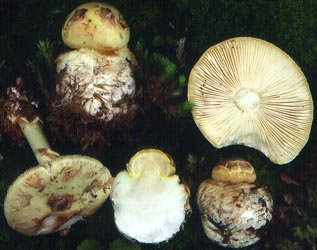|
[ Section Validae page. ] [ Amanita Studies home. ] [ Keys & Checklist/Picturebooks ] Amanita bulbosa var. citrina (Schaeff.) Gillet"Schaeffer's Citrine Bulbous Amanita" =Agaricus citrinus Schaeff. non Gunnerus =Agaricus mappa Batsch ?? : Fr.
Technical description (t.b.d.) BRIEF DESCRIPTION: The following is based on the description by Neville and Poumarat (2004) and data from RET based on Scottish material. The cap of Amanita bulbosa var. citrina is 40 - 100 mm wide, whitish yellow to citron yellow, with pigment most saturated in the center, sometimes touched with rusty brown here and there, hemispheric then convex, plano-convex, finally planar, usually lacking an umbo, smooth, shiny and slightly viscid at first, drying quickly, with a nonstriate and nonappendiculate margin. The volva is absent or present as citron or pallid at first, pale brown to brownish to brownish white friable cluster of warts to one submembranous patch to fibrillose, concentrically arranged scales, easily removable. The flesh is white, tinted citron just below the cap skin, 5 mm thick over the stem, and thinning evenly to the margin. The gills are free to narrowly adnate, rather crowded, very pale orangish white to cream to white to citron tinted white, 5.5 - 10 mm broad, with a decurrent line on the stem and a finely fibrillose edge. The short gills are truncate to rounded truncate to subattenuate and plentiful. The stem is 50 - 150 × 6 - 18 mm, satiny, cylindric, stuffed becoming hollow, white, above the ring at times tinted citron strongly or lightly striate or sometimes appearing to be sheathed with pale citron yellow material. The bulb is 20 - 40 × 21 - 40 mm, marginate, subhemispherical to subglobose. The ring is membranous, skirt-like, rather thin, superior to subsuperior, pale citron yellow, browning in age, finely striated on the upper side in young specimens, with finely flocculose on the margin and on the underside especially near the edge, and eventually collapses on the stem. The volva is present as a very short limb on only one side or as a white to browning ridge on the outer edge of the flattened upper bulb surface. Sometimes a large portion of the volva remains connected to the bulb forming a coherent but fragile limb. The flesh is white. The odor is like radish. Spores of this taxon measured by RET are as follows: (6.9-) 7.5 - 10.0 (-16.0) × (6.0-) 7.0 - 8.8 (-10.4) µm and are globose to subglobose, rarely broadly ellipsoid or ellipsoid, and amyloid. Clamps are absent from the bases of basidia. Spores measurements from Neville and Poumarat (2004) are as follows: 7 - 9 (-9.5) × 6 - 8.5 (-9) µm and are globose to subglobose to broadly ellipsoid. This variety was described from Germany (Bavaria) and is known from Europe and western Asia -- the same range as the type variety (A. bulbosa (Schaeff.) Lam. var. bulbosa). Neville and Poumarat state that the present taxon is common in summer and autumn in Europe and may occur in the spring. They include an extended list of potential host trees including pines (Pinus) and broad-leafed species such as birch (Betula), chestnut (Castanea), beech (Fagus), Eucalyptus, and oak (Quercus). The taxa known as "A. citrina" in North America are distinct species one of which is A. citrina f. lavendula (Coker) Veselý (an entity that, at least in the Fall when nights become cold, may exhibit lavender staining or bruising). The second North American species was unfortunately placed in A. brunnescens G. F. Atk. at the rank of variety when it was first described. It would be correct, but confusing, to call the second American "citrina" A. brunnescens var. straminea E.-J. Gilbert. I usually refer to the latter as "A. citrina in the sense of American authors." Its range extends at least from southern Québec and northern Michigan to eastern Hidalgo edo., México. For a discussion of the experimental "hypermagenta test" for separating some European and North American collections of "citrina," see the web page for Amanita citrina f. lavendula (link is above). Asian material ascribed to this species is more likely A. sinocitrina Zhu L. Yang, Z. H. Chen & Z. G. Zhang or A. citrina var. grisea (Hongo) Hongo. -- R. E. Tulloss Photo: R. E. Tulloss (England). [ Section Validae page. ] [ Amanita Studies home. ] [ Keys & Checklist/Picturebooks ] Last changed 29 September 2009. |
